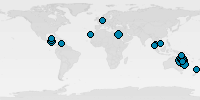
Crocodile Avenue offers small sandy patches with empty stretches of sand and oases of life.
| Name Dive Site: | Crocodile Avenue |
| Depth: | 5-20m (16-65ft) |
| Visibility: | 5-20m (16-65ft) |
| Inserted/Added by: | malaysia_liveaboards |
| Rated: | Rated not yet |
| Specifications: |   |
Send us your images for this dive site[Add Image][Add Movie]
This is another muck (macro) diving site that Borneo generally and Mabul Island in particular has become famous for. It's another shallow site with a maximum depth of 20m. Visibility can be as high as 20m in high season but is more likely to be 5-10m especially in the off season. Good buoyancy control is required so as not to kick up any more sediment. Poor underwater visibility isn't a problem though as everything that divers will be looking at is small and close by, there is no gazing into the blue open ocean on this dive. There is also no need to worry about crocodiles appearing out of the murky water and dragging you away in their jaws. The crocodile fish that this dive site is named after are far less threatening, spending their time camouflaged on the sandy bottom.
Other critters to look out for here are seahorses and their relatives the pipefish. Ornate ghost pipefish can be found drifting in the current just off the sea bed. Bent stick pipefish cunningly disguise themselves as, yes you guessed it, bent sticks. They may not be the most exciting fish in the world but there is a certain thrill in finding something so well hidden. Also in the sand are garden eels. Various nudibranch species, many of them with no common name, just Latin ones, live on patches on coral. Frogfish and leaf fish can be seen here as can scorpionfish and lionfish. There are thousands of shrimps and gobies in the sand, often working together in a symbiotic relationship.
Night dives are also popular on this dive site when all the same critters are still in evidence and it may also be possible to see cuttlefish, often in pairs. Even eagle rays have been spotted here.
[Add Message]Messages from readers:
[Add Divelog]Divelogs from members:
